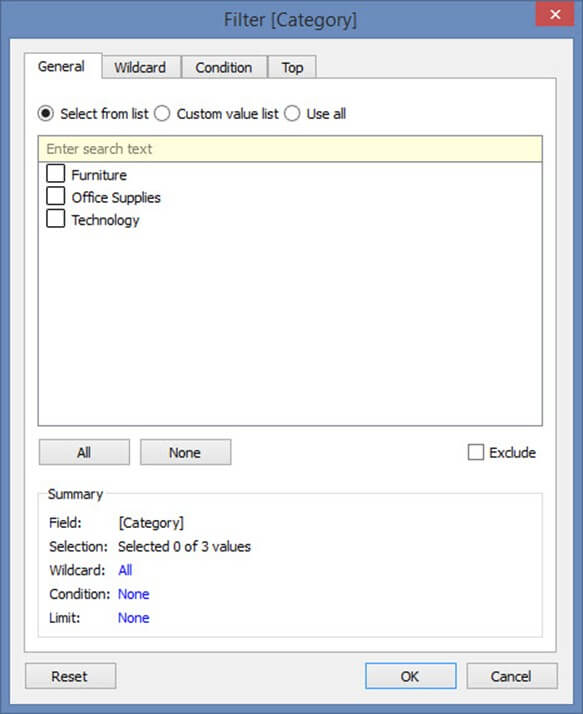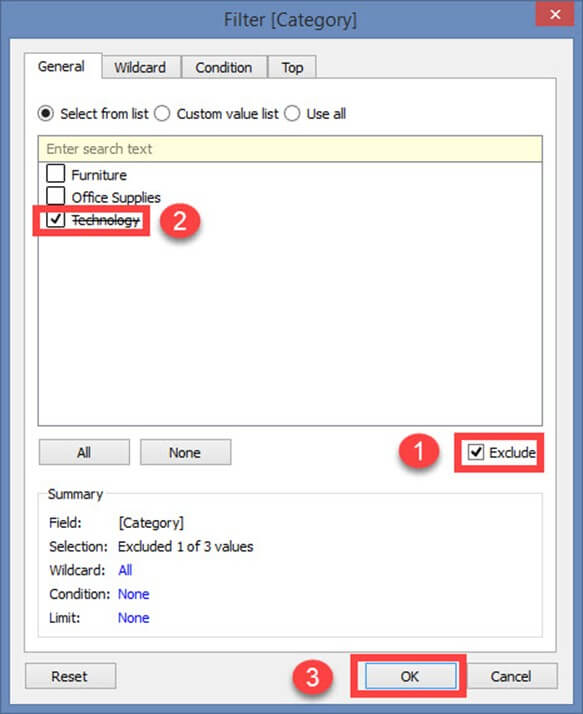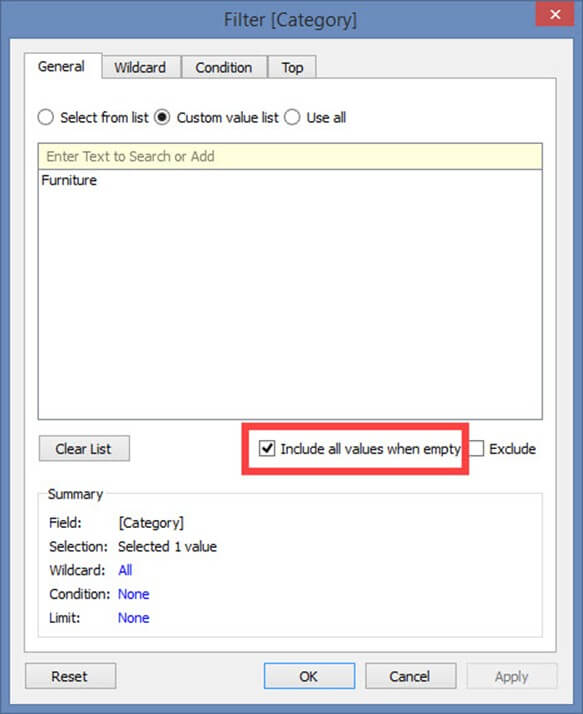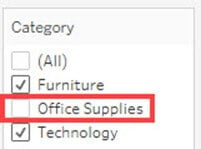How To Filter In Tableau
Data can be organized and simplified by using various techniques in Tableau. We volition use the "Sample– Superstore.csv" text file for demonstration in this tutorial.
In this tutorial you will learn
- Types of Filters:
- Excerpt Filters:
- Filter status in Tableau
- Filter Condition past Formula:
- Information Source Filter:
- Context Filter:
- Dimension Filters:
Types of Filters:
The filters can be applied in a worksheet to restrict the number of records nowadays in a dataset. Various types of filters are used in Tableau Desktop based on different purposes. The different types of filters used in Tableau are given below. The name of filter types are sorted based on the lodge of execution in Tableau.
- Extract Filters
- Data Source Filters
- Context Filters
- Dimension Filters
- Measure Filters
Extract Filters:
Excerpt filters are used to filter the extracted data from data source. This filter is utilized only if the user extracts the information from information source.
Once the text file is connected to Tableau, you tin run into the live and extract choice in the height right corner of information source tab. Live Connection directly connects to a information source. Extract connection extracts the data from data source and creates a local re-create in Tableau repository. The procedure for creating an extracting filter is given as follows.
Step 1) Afterward connecting the text file into Tableau,
- Click on "Extract" radio button equally shown in the figure.
This volition create a local copy in Tableau repository.

Step 2) Next,
- Click on the 'Edit' selection placed near to Excerpt button.
- It opens "Excerpt data" window. Click on 'Add together' option present in the Window.

Pace three) "Add Filter" Window is open to select the filter weather.
You can choose any of the fields and add as extract filter. In this example, we have selected'Category' every bit excerpt filter.
- Select 'Category' from the list
- Click on 'OK.'

Once you lot click on OK button, it opens a filter window.

The filter window has multiple options to filter 'Category' based on various use case. All the use cases and its filter conditions are explained below.
Filter condition in Tableau
Use Instance i: Select from List
Past default, filter window opens the "Select from List" option. Yous can include or exclude the members present in the field using this option.
To include you can
- Select the members
- Click on OK.

To exclude the selected members,
- Click on exclude checkbox
- Select the members to exclude
- Click on OK.

There are ii more choice in the "Select from List".
- All
- None
All:
This pick includes or excludes all members nowadays in the field. In this example, all members are included by clicking on "All" pick.
Pace ane)
- Select 'All' option.
- Click on OK

Pace 2) Next,
- It shows excerpt data filter. The filter condition is besides added in the excerpt filter window.
- Click on OK to add the excerpt filter.

To exclude all the members in the list, first, click on 'Exclude' button. Then select 'All' selection and click on OK. This procedure adds the filter in extract information filter window.

None:
If yous want clear all the selection made in the filter window and get-go a new selection, you can use this 'none'choice. None selection clears all the selection fabricated in the filter window. Once it is cleared you can select the new members.
- Click on the 'None' selection. Select the new members to be added as filter.
- Click on OK to add the extract filter.

Use Case two: Custom Value List
A custom value listing allows the user to type the member proper noun and filter the field accordingly. A custom value list can be created by following the given procedure.
Pace 1) In the Filter Screen
- Click on "Custom value listing" radio push.
- Type the member name.
- Click on '+' symbol to add the name in the listing.
- You can add multiple members in the listing and click on OK

There is an choice in the window "Include all values when empty." Information technology can be selected to include all values present in the field when the selected member has no data.

Clear Listing option clears the community value list.

Employ Case 3: Use all
This selection selects all the members present in the field.

Use instance 4: Wildcard
Wildcard option is used to filter the fields based on given wildcard match. Users can type the character and filter the field based on the match. The different types of matches are given as follows.
| Contains | Select the members if the member name contains typed characters. |
| Starts with | Select the members if the member name starts with typed characters. |
| Ends with | Select the members if the fellow member name ends with typed characters. |
| Exactly matches | Select the members if the member name exactly matches with typed characters. |
Stride i)
- Select the "Wildcard" tab.
- Type the characters to friction match.
- Select the blazon of match. In this instance "Contains" match blazon is selected.
- Click on OK.

Use Case 5: Filter on Condition
This option is used to filter the information set by giving several weather. Filer condition based on field is given beneath.
By Field:
- Select the 'Status' tab in Filter Window.
- Click on radio button 'By field.'
- Select the name of the field to be filtered from the drib-down list.
- Select the aggregation blazon like Sum, average and median from the drop-downward list.
- Choose the operator from the drop-down.
- Enter the value to filter the selected field.
- Click on OK.

In the in a higher place case, the dataset is filtered to see the data where the sum of sales is greater than 1000.
The range of Values:
This option shows the minimum and maximum value of the selected field by clicking on 'Load' push button. It tin be used to refer the values.

Filter Condition by Formula:
You lot can write a formula to filter the dataset using this selection. The procedure is explained below.
Steps:
- Click on radio push 'Past formula.'
- Enter the formula in the box as shown in the figure.
- Click on Ok.

In the above example, the written formula filters the data where sum of sales is greater than thousand.
Apply Case half dozen: Meridian or bottom filters
This choice is used to select top or bottom 'northward' number of records.
By Field:
Step ane)
- Select 'Pinnacle' tab from the filter window.
- Click on radio push button 'By field'.

Footstep two)
- Select 'Top' or 'Lesser'.
- Choose the number of records.
- Select the field.
- Choose the assemblage blazon.
- Click on Ok.

In the above case, the filter restricts the data set to show height 10 records based on the sum of sales.
By Formula:
The meridian or bottom status tin can also exist given through formula.
Steps:
- Click on the radio button 'By Formula'.
- Select 'Top' or 'Bottom'.
- Choose the number of records.
- Enter the formula.
- Click on OK.

In the to a higher place example, the formula was written to show height x records based on the sum of sales.
Information Source Filter:
A data source filter is used to filter the data in information source level. It can restrict the records present in the data ready. This filter is similar to extract filter on securing the information. But data source filter and extract filter is not linked to each other. Data source filter works on both live and extracts connection. The process to select data source filter is given as follows.
Pace 1) Click on the 'Add together' button placed on the top right corner of the data source tab.

Step 2) Information technology opens the 'Edit Information Source Filters' Window. Click on 'Add together' Pick present in the window.

After clicking on 'add together' button, follow the remaining steps from the topic 'Extract Filters' -> Footstep 3.
Context Filter:
A Context filter is an independent filter that can create a split dataset out of the original data set and compute the selections made in the worksheet. One or more categorical filter that separates the dataset into major parts tin can be used every bit a context filter. All other filters used in the worksheet works based on the selection of context filter. The functions of context filters tin be explained through an excel canvass.

The effigy shows a sample dataset. From the dataset, it is identified that 'Category' can be used equally context filter as it can carve up the dataset into major parts. Once the filter is practical to the dataset, the following data can be obtained.

When the category "Article of furniture" is selected, the information available in the detail category is shown in the effigy. Other filters that tin exist practical in the canvas volition be dependent on the category filter. This is the basic part of using context filter. Tableau creates a temporary dataset in repository engine based on the context filter pick. In one case context filter is selected, all other selections and filters depend on the selection of specific context filter. The temporary table or data fix that is created on selecting context filter loads whenever the context filter is inverse.
Apply Context Filters in Worksheet:
Any dimension can exist added as context filter by following the steps given below:
Pace 1) The dimension to be added as context filter needs to be added in filter department box equally given in the paradigm.

Step 2) Right click on the dimension added in the filter section and select "Add to Context" pick.

Step 3) Once the filter is selected every bit a context filter, the color of dimension box changes to grey color. This grey colour box is an indication of context filter.

Removing Context Filter:
Any context filter can be inverse back to normal filter past selecting the "Remove from Context" option which is bachelor when right-clicking on the dimension. The color of dimension box will also change back to blue color every bit an indication.

Advantages of Using Context Filters:
Improve Performance:
When context filter is used in large data sources, it tin can improve the performance as information technology creates a temporary dataset part based on the context filter selection. The operation can be effectively improved through the pick of major categorical context filters.
Dependent Filter Conditions:
Context filters tin be used to create dependent filter atmospheric condition based on the business organization requirement. When the data source size is large, context filter can exist selected on the major category, and other relevant filters tin exist executed.
Dimension Filters:
When a dimension is used to filter the information in a worksheet, it is called every bit Dimension filter. Information technology is a non-aggregated filter where a dimension, group, sets and bin tin be added. A dimension filter tin can be applied through the superlative or bottom conditions, wildcard match and formula.
The members present in a dimension tin can be included or excluded from the listing using this filter. Dimension filter tin can exist shown in a sheet or dashboard to change the filter condition dynamically. The procedure for adding a dimension as the filter is given equally follows.
Step i) Go to a worksheet every bit given in above topics and follow the steps.
- Select a dimension from the dimension listing. In this example 'Category' is called from the dimension list. Elevate the dimension into 'Filters' box.
- Information technology opens the 'Filter' Window. Select the member from the list.
- Click on OK.

The above procedure filters data set to show the records only for category 'Furniture.'

Measure out Filter:
A measure filter can filter the data based on the values nowadays in a measure. The aggregated measure values tin can exist used in measure filter to modify the information. A measure filter can be applied in a worksheet past following the procedure.
Step i) Get to a Worksheet
- Select a mensurate present in the Measures tab. In this example, 'Sales' is selected. Drag the measure out into 'Filter' box.
- It opens a 'Filter field' window. Select any of the aggregation from the list. In this example, Sum is taken as aggregation type.
- Click on 'Next' button.

Step two) It opens a window where you demand to select the range of values. The other types of options present in the window are given as follows.
| Range of values | Minimum and maximum range of measure value can be given and filtered. |
| At least | A minimum value of a measure is given to filter the information. |
| At most | A maximum value of a measure is given to filter the data. |
| Special | An option to select nil or non-aught values and filter the data. |
- Select the range of values. You can modify the upper and lower limit for the range of values.
- Click on OK.

The above example filters the data set based on the sum of sales value between 0 and 22638.
Custom or Quick Filter:
Filters can be customized based on the user pick. The filters tin can customize worksheets and dashboards to change the information dynamically. The procedure to customize the filter is given as follows.
Step i) Add the 'Category 'filter as shown in the topic Dimension filter.
- Right-click on the filter added.
- Select 'Prove Filter' option.

Step ii) It shows the 'Category' filter box in the correct side of the worksheet. By default, the filter shows the multi-value list as shown in the figure.

Step 3) Yous can select or unselect members present in the filter and modify the data.

User Filter:
User filter secure the row level data present in a dataset. It can exist used when publishing the workbook on a server. Different filter weather condition tin be applied for unlike users. For example, assume there are iii departments in a business firm namely Piece of furniture, Office Supplies, and Technology. By using the user filter, we tin allow the users to show merely the data relevant to their section. i.e., Users from 'Furniture' department can just see the data from category 'Furniture'. This can assure the security of row level data. The procedure to employ the user filter is given as follows.
Stride 1)
- Click on the Server option nowadays in the Menu bar.
- Hover over the 'Create User Filter' option.
- Select the field to create user filter. In this example, the category is selected every bit user filter.

Step 2)
- It opens a 'Tableau Server Sign in' window.
- Click on 'Tableau Online' option nowadays in the window.

Footstep iii)
- Information technology opens a Tableau Online Sign in Window. Enter your registered e-mail id and countersign.
- Click on Sign In option.

Stride 4) It opens a 'User Filter' window. Follow the below steps to add together user filter.
- Enter a name for the user filter.
- Select a user form the user's listing.
- Check in the required members need to show for the selected member.
- Click on OK.

It creates a user filter in Tableau. You tin view the user filter under sets pane equally shown below.

When the workbook is published in the server, only the filtered data is shown to the user. User filter tin can be created for multiple users to secure the information.
Summary:
- Tableau has features to organize and simplify the data nowadays in the data set.
- Filter restricts the number of records present in data prepare based on given condition.
- Various types of filters used in Tableau are extract filters, data source filters, context filters, dimension filters and mensurate filters.
- Extract filters modify the data in the local copy of information set which is extracted from the data source.
- Data source filters change the information based on given condition. These filters apply on both alive and extract connection.
- Context filter creates a temporary table in Tableau engine and acts as a primary filter. All the other filters applied on a worksheet depend on the Context filter.
- When a dimension is used to filter the data, it is called equally dimension filter. It can include or exclude the members present in the dimension.
- When a measure is used to filter the data, information technology is called as measure filter. It tin modify the data based on the comparison of measured value.
- A quick or custom filter is used to modify the filter condition dynamically.
- User filters secure the row level data published in a server.
- Users tin can sort the fields present in the data ready.
- Groups can be building to grouping the members present in a dimension.
- Users can build bureaucracy to show the granularity level present in the dataset.
- Sets can exist created to select or exclude one or more than members from a field. A set can be added equally a split up dimension in Tableau.
How To Filter In Tableau,
Source: https://www.guru99.com/filter-data-tableau.html
Posted by: smithloond1969.blogspot.com


0 Response to "How To Filter In Tableau"
Post a Comment